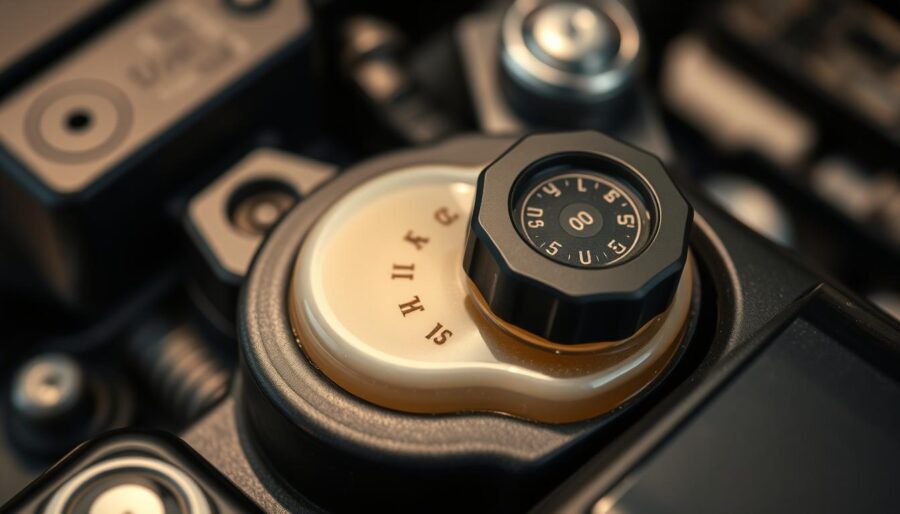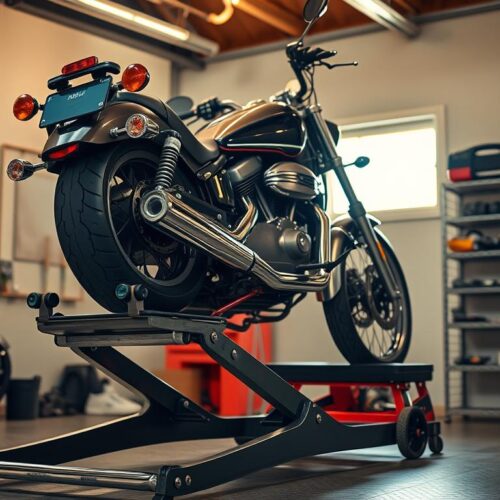Having your motorcycle work safely means you need regular check-ups. A key part often missed is checking the brake fluid. This fluid is super important because it helps your brakes work right, and keeping it in good shape is crucial for your safety. Over time, brake fluid can get water in it and not work so well. This can make braking slower and dangerous.
In this guide, you’re going to learn why it’s necessary to change your brake fluid. Plus, you’ll get simple steps to check it yourself. This ensures your motorcycle stays in great shape.
Why Brake Fluid is Important for Your Safety
Brake fluid plays a key role in motorcycle safety. It makes sure your bike stops smoothly and quickly. By pushing the brake lever, this fluid spreads force to the brakes. This helps your motorcycle to halt efficiently. Without the right brake fluid, your brakes might not work well, especially during temperature changes.
Dirty brake fluid can be very dangerous. It can cause the brakes to become less effective. This means you might not stop in time, raising the risk of crashes. Corroded brake parts from bad fluid can be costly to fix. They might even lead to brakes failing while riding. To prevent these issues, it’s important to check your brake fluid often. For tips on keeping your bike in top shape, see this helpful guide.
Types of Brake Fluid Used in Motorcycles
Understanding brake fluid types is key in motorcycle upkeep. Brake fluid is classified by DOT ratings, showing performance and boiling points. Each type suits different riding styles and bikes.
DOT 3 is common and works well for most bikes. But, it can lose effectiveness as it absorbs moisture. Hence, regular checks are crucial. For high-performing bikes, DOT 4 offers better boiling points and suits extreme conditions well. DOT 5.1, like DOT 4, is glycol-based and boosts performance in bikes with anti-lock braking systems (ABS).
Choosing the right brake fluid is important. Wrong fluid can damage your bike and make braking unsafe. Always check your owner’s manual for the best brake fluid type for your bike.
| DOT Rating | Boiling Point (°F) | Properties | Compatibility |
|---|---|---|---|
| DOT 3 | 401 | Adequate for standard motorcycles | General bikes |
| DOT 4 | 446 | Higher performance, better heat resistance | Performance bikes |
| DOT 5 | Not specified | Silicone-based; not suitable for all systems | Specialist applications only |
| DOT 5.1 | 500 | High-performance brake fluid, glycol-based | ABS and performance bikes |
Signs You Need a Brake Fluid Check
Keeping an eye on your motorcycle’s brake fluid is key for road safety. Signs of brake fluid issues include dashboard warning lights. These warn of low fluid or leaks that need quick action.
Notice any changes in how your brakes work. If braking feels spongy or less powerful, it’s time to check the brake fluid. Addressing these signs early can avoid bigger problems later.
Checking the brake fluid’s color is another smart move. It should be light yellow when it’s clean. Dark or cloudy fluid means contamination and requires immediate change. This keeps your brakes working right.
How Often Should You Check Your Brake Fluid?
Checking your brake fluid regularly is key to keeping your bike safe. Experts suggest looking at it every 12 to 24 months. It doesn’t matter how much you ride. This is because brake fluid draws in moisture over time.
Several things can make your brake fluid go bad faster. Riding in humid places or braking hard often might mean checking it more. Where you ride, how you ride, and your brake fluid type matter a lot.
Following these tips helps keep your brakes working well. It makes your ride safer and more enjoyable.

Tools You Will Need for the Inspection
Getting ready to check your motorcycle’s brake fluid is key. You need the right tools to make it go smoothly. Start with different-sized spanners; you’ll likely need 8mm, 9mm, and 10mm to open the bleed nipples. A brake fluid bleed kit is also essential for this task.
Don’t forget about safety. Gloves and safety glasses keep you safe from brake fluid, which can hurt your skin and mess up paint. Use paper towels to clean spills fast, keeping your work area neat and safe. Here’s a full list of tools for checking brake fluid:
| Tool | Purpose |
|---|---|
| Spanners (8mm, 9mm, 10mm) | Loosen bleed nipples for brake fluid access |
| Brake Fluid Bleed Kit | Assist in removing and replenishing brake fluid |
| Gloves | Protect skin from brake fluid damage |
| Safety Glasses | Shield eyes from splashes |
| Paper Towels | Clean up any spills to maintain workspace |
The Step-by-Step Brake Fluid Inspection Process
To start a detailed brake fluid inspection, follow these easy steps. First, find the brake fluid reservoir. It’s near the front brake lever or the foot pedal for rear brakes. Look at the brake fluid level. Make sure it’s between the “MIN” and “MAX” lines on the reservoir.
Now, examine the fluid’s clarity. Good brake fluid looks clear. If it’s cloudy or looks strange, it might be dirty. Do tests for dirt by looking for air bubbles or particles in the fluid. These can lower brake efficiency and safety.
Keep doing these checks often to keep your motorcycle’s brakes working well. If something seems wrong, talk to an expert for more help.
Changing Your Motorcycle’s Brake Fluid: Overview
Changing your motorcycle’s brake fluid is crucial. It makes sure your brakes work well and safely. If the fluid gets old or dirty, your brakes won’t work as well. This could cause accidents. It’s important to keep up with maintenance to stay safe on the road.
Before starting, get all the tools and materials ready. You’ll need new brake fluid, a wrench, and something to siphon with, like a turkey baster. Also, grab some clean rags. Working in a clean, flat area will help avoid any mess and make the job go smoothly.
Always check the manufacturer’s guidelines for when to change your brake fluid. Doing this keeps your brakes working their best. It also stops potential brake failure from not taking care of them.
Step-by-Step Guide to Changing Brake Fluid
It’s vital to change your motorcycle’s brake fluid to keep your brakes working well. Here’s how you can switch out the brake fluid properly.
- Prepare Your Workspace: Gather all needed tools first. This includes a brake fluid bleed kit, a wrench for the bleed nipple, and new brake fluid that matches what your motorcycle manufacturer recommends.
- Drain the Old Fluid: Begin by removing the old brake fluid from the lines. Open the bleed nipple with the bleed kit. Press on the brake lever to let the fluid out. Watch the process to get all the old fluid out.
- Refill the Reservoir: After draining, fill up the brake fluid reservoir with new fluid. Be sure to use the right type for your motorcycle, according to the manufacturer’s advice. This ensures everything works as it should.
- Bleed the Brakes: Then, you need to bleed the brakes by opening the bleed nipple again and pressing the brake lever. Bleeding gets rid of any air in the system. This makes the brakes respond better and more reliably.
- Check for Leaks: Once you’ve bled the brakes, look over the nipple and lines for leaks. Tighten them if needed. Make sure to clean up any spilled fluid to protect your motorcycle’s paint.

Safety Precautions When Handling Brake Fluid
Safety is crucial when working with brake fluid. It can irritate your skin and seriously harm your eyes. Always use protective gloves and safety glasses. These steps lower your injury risk.
Avoid letting brake fluid touch your skin. Make sure your workspace has plenty of air flow. Clean up any spills right away. This prevents surface damage and environmental risks. Following these tips ensures your safety.
Proper disposal of old brake fluid is important. It’s labeled as hazardous waste. Many auto parts stores offer disposal advice. They help you follow local laws and protect nature. Safe disposal practices are good for the planet.
Recognizing When to Seek Professional Help
Checking and changing brake fluid is often a DIY task. But, you should know when to get a mechanic’s help. This is key if your dashboard’s warning lights stay on. These lights may show problems that need a deeper look.
Strange sounds when braking or a change in how your brakes respond can mean trouble. Such issues point to brake fluid problems that need expert care.
Seeing these signs means it’s time to find a pro motorcycle service. Choose a shop with skilled techs for complex brake problems. Go for someone with great reviews and a strong track record. This ensures your bike gets top-notch treatment.
Maintenance Tips for Prolonging Brake Fluid Life
Keeping your motorcycle’s brake fluid fresh is key. Regularly check it and follow what the maker says about changing it. Here are some tips to keep your brake fluid good for longer:
- Check fluid levels frequently and top off as necessary to avoid running low.
- Avoid mixing different types of brake fluid, as this can lead to chemical reactions that compromise performance.
- Always close the brake fluid reservoir properly after checking or adding fluid to prevent exposure to contaminants.
- Inspect brake lines for leaks or cracks, which can introduce moisture and debris into the fluid.
- Consider flushing and replacing the brake fluid every one to two years, depending on usage and manufacturer recommendations.
It’s very important to prevent contamination to keep the fluid working right. Keeping your brake fluid and system in great shape means a safer ride. It also helps you avoid spending a lot on repairs.
Conclusion: Keeping Your Motorcycle Brakes in Top Condition
Keeping your motorcycle brakes in good shape is key for safe riding. It’s important to regularly check your brake fluid. This keeps your brakes working well and keeps you safe on the road.
To make sure your brakes are always ready, follow the advice in this article. Setting up a routine for checking and changing your brake fluid is smart. Doing this improves your brakes and makes riding safer.
If you want more info on small motorcycle fixes, check out this resource. Remember, taking care of your brakes is about more than just good performance. It’s about keeping you safe every time you ride.




